11-4
Catalyst 3750 Switch Software Configuration Guide
78-16180-02
Chapter 11 Configuring Interface Characteristics
Understanding Interface Types
Configure routed ports by putting the interface into Layer 3 mode with the no switchport interface
configuration command. Then assign an IP address to the port, enable routing, and assign routing
protocol characteristics by using the ip routing and router protocol global configuration commands.
Note Entering a no switchport interface configuration command shuts down the interface and then re-enables
it, which might generate messages on the device to which the interface is connected. When you put an
interface that is in Layer 2 mode into Layer 3 mode, the previous configuration information related to
the affected interface might be lost.
The number of routed ports that you can configure is not limited by software. However, the
interrelationship between this number and the number of other features being configured might impact
CPU performance because of hardware limitations. See the “Configuring Layer 3 Interfaces” section on
page 11-21 for information about what happens when hardware resource limitations are reached.
For more information about IP unicast and multicast routing and routing protocols, see Chapter 34,
“Configuring IP Unicast Routing” and Chapter 36, “Configuring IP Multicast Routing.”
Note The standard multilayer image (SMI) supports static routing and the Routing Information Protocol
(RIP). For full Layer 3 routing or for fallback bridging, you must have the enhanced multilayer image
(EMI) installed on the stack master.
10-Gigabit Ethernet Interfaces
The Catalyst 3750G-16TD switch has one 10-Gigabit Ethernet interface. The switch uses a 10-Gigabit
Ethernet XENPAK module to establish connections to networks.
The 10-Gigabit Ethernet interface only operates in full-duplex mode. The interface can be configured as
a switched port or a routed port. A stack of Catalyst 3750 switches can have up to nine 10-Gigabit
Ethernet interfaces. A cross-stack EtherChannel supports up to two 10-Gigabit module ports.
For the latest information about XENPAK modules supported by the switch, refer to the release notes.
For more information about XENPAK modules, refer to your XENPAK module documentation.
Note The 10-Gigabit Ethernet module ports are referred to as 10-Gigabit Ethernet XENPAK modules in the
hardware installation guide.
Switch Virtual Interfaces
A switch virtual interface (SVI) represents a VLAN of switch ports as one interface to the routing or
bridging function in the system. Only one SVI can be associated with a VLAN, but you need to configure
an SVI for a VLAN only when you wish to route between VLANs, to fallback-bridge nonroutable
protocols between VLANs, or to provide IP host connectivity to the switch. By default, an SVI is created
for the default VLAN (VLAN 1) to permit remote switch administration. Additional SVIs must be
explicitly configured. SVIs provide IP host connectivity only to the system; in Layer 3 mode, you can
configure routing across SVIs.
